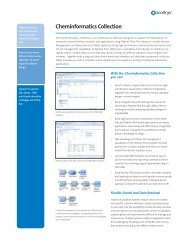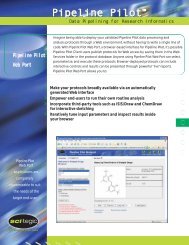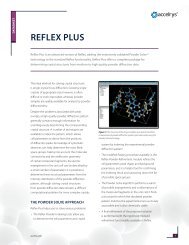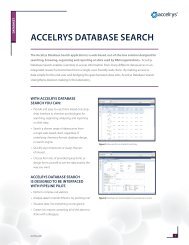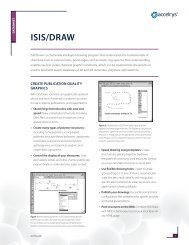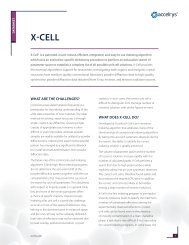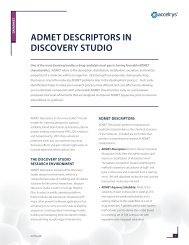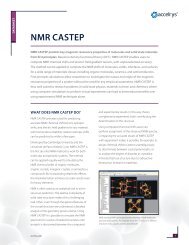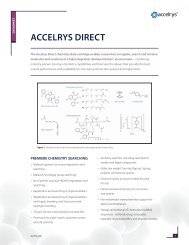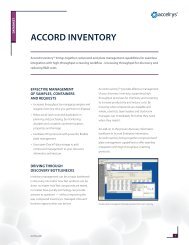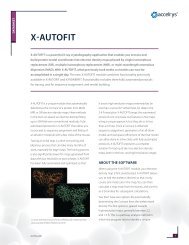SIMulatIon of non-IonIC SurfaCtant MICelleS for ... - Accelrys
SIMulatIon of non-IonIC SurfaCtant MICelleS for ... - Accelrys
SIMulatIon of non-IonIC SurfaCtant MICelleS for ... - Accelrys
Create successful ePaper yourself
Turn your PDF publications into a flip-book with our unique Google optimized e-Paper software.
oBjeCtIve:<br />
The objectives <strong>of</strong> this work were to gain insight on the<br />
localization <strong>of</strong> different molecules incorporated into<br />
the micelles, and on the influence <strong>of</strong> the <strong>for</strong>mulation<br />
on the final morphology <strong>of</strong> the solutions.<br />
Methodology:<br />
Following the use <strong>of</strong> atomistic modeling to estimate the<br />
thermodynamic properties <strong>of</strong> the <strong>non</strong>-ionic surfactant<br />
and the drug (Materials Studio® Discover and COMPASS<br />
<strong>for</strong>cefield), a suitable coarse-grained model <strong>for</strong> the<br />
surfactants, the drug molecule and the solvents were<br />
generated (Figures 1 and 2). Mesoscale modeling was then<br />
per<strong>for</strong>med to study the morphology <strong>of</strong> five simple systems<br />
with increasing complexity (Materials Studio® DPD®):<br />
• Non-ionic surfactant in water solution<br />
• Non-ionic surfactant and hydrophobic drug in water solution<br />
• Non-ionic surfactant, hydrophobic drug<br />
and polar solvent in water solution<br />
• Non-ionic surfactant, hydrophobic drug, preservative<br />
and polar solvent in water solution<br />
• Non-ionic surfactant, hydrophobic drug and <strong>non</strong>-ionic<br />
polymeric surfactant in water solution<br />
reSultS:<br />
For the system consisting <strong>of</strong> the <strong>non</strong>-ionic surfactant in<br />
aqueous solution, a micellar solution was obtained (Figure 3).<br />
The size <strong>of</strong> the micelles was found to be nearly independent<br />
<strong>of</strong> the temperature and <strong>of</strong> the surfactant concentration in<br />
the range 1% to 4%. As the drug was added to the system,<br />
the micelle size was reduced, with the drug concentrating<br />
at the core-corona interface. Additionally, the impact <strong>of</strong> the<br />
solvent quality was studied and it was found that under worst<br />
solvent conditions, the drug diffused out <strong>of</strong> the micelle.<br />
accelrys.com<br />
CASE STUDY: MATEriAlS STUDio<br />
figure 1. Atomistic model <strong>of</strong> the <strong>non</strong>-ionic surfactant molecule.<br />
figure 2. Coarse-grained model <strong>of</strong> the <strong>non</strong>-ionic surfactant molecule.<br />
figure 3. Surfactant micelle in aqueous solution (water<br />
not shown).<br />
2



